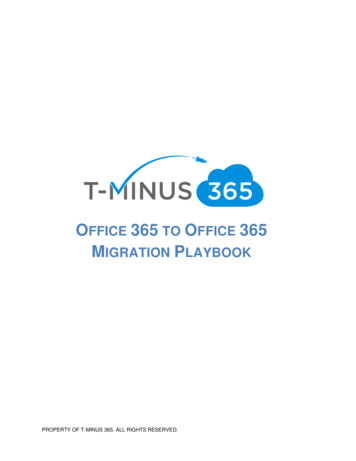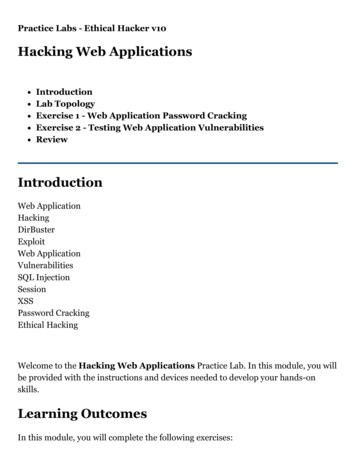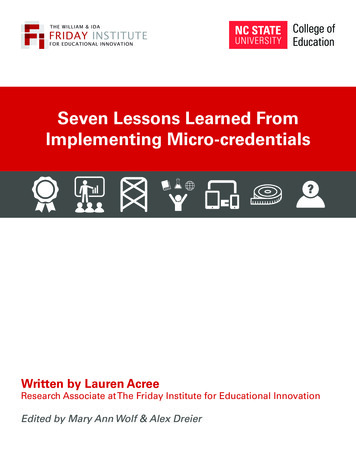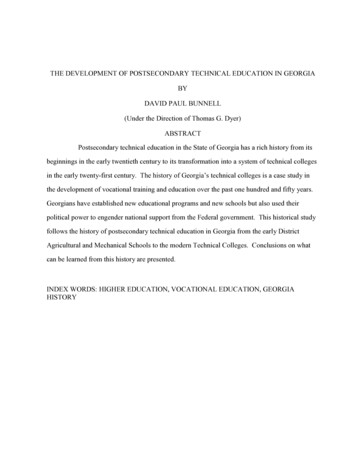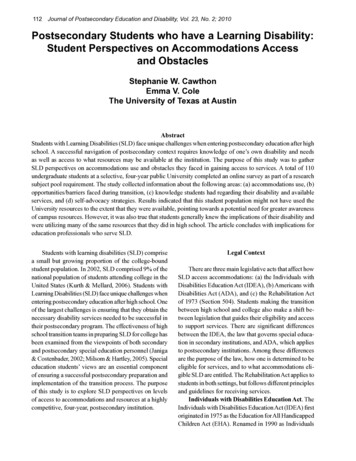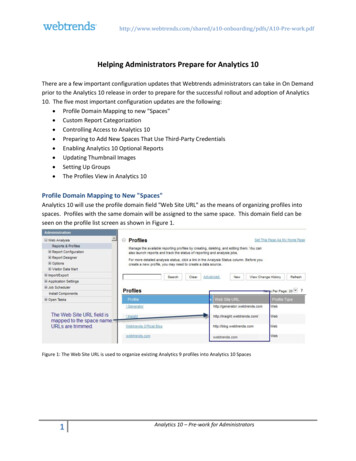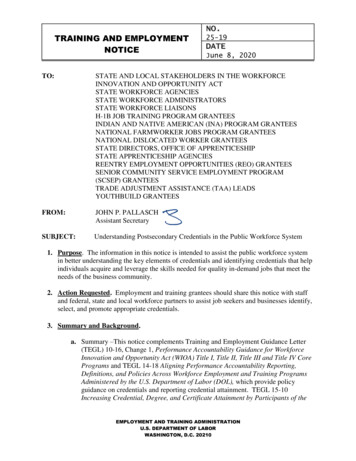
Transcription
TRAINING AND EMPLOYMENTNOTICENO.25-19DATEJune 8, 2020TO:STATE AND LOCAL STAKEHOLDERS IN THE WORKFORCEINNOVATION AND OPPORTUNITY ACTSTATE WORKFORCE AGENCIESSTATE WORKFORCE ADMINISTRATORSSTATE WORKFORCE LIAISONSH-1B JOB TRAINING PROGRAM GRANTEESINDIAN AND NATIVE AMERICAN (INA) PROGRAM GRANTEESNATIONAL FARMWORKER JOBS PROGRAM GRANTEESNATIONAL DISLOCATED WORKER GRANTEESSTATE DIRECTORS, OFFICE OF APPRENTICESHIPSTATE APPRENTICESHIP AGENCIESREENTRY EMPLOYMENT OPPORTUNITIES (REO) GRANTEESSENIOR COMMUNITY SERVICE EMPLOYMENT PROGRAM(SCSEP) GRANTEESTRADE ADJUSTMENT ASSISTANCE (TAA) LEADSYOUTHBUILD GRANTEESFROM:JOHN P. PALLASCHAssistant SecretarySUBJECT:Understanding Postsecondary Credentials in the Public Workforce System1. Purpose. The information in this notice is intended to assist the public workforce systemin better understanding the key elements of credentials and identifying credentials that helpindividuals acquire and leverage the skills needed for quality in-demand jobs that meet theneeds of the business community.2. Action Requested. Employment and training grantees should share this notice with staffand federal, state and local workforce partners to assist job seekers and businesses identify,select, and promote appropriate credentials.3. Summary and Background.a. Summary –This notice complements Training and Employment Guidance Letter(TEGL) 10-16, Change 1, Performance Accountability Guidance for WorkforceInnovation and Opportunity Act (WIOA) Title I, Title II, Title III and Title IV CorePrograms and TEGL 14-18 Aligning Performance Accountability Reporting,Definitions, and Policies Across Workforce Employment and Training ProgramsAdministered by the U.S. Department of Labor (DOL), which provide policyguidance on credentials and reporting credential attainment. TEGL 15-10Increasing Credential, Degree, and Certificate Attainment by Participants of theEMPLOYMENT AND TRAINING ADMINISTRATIONU.S. DEPARTMENT OF LABORWASHINGTON, D.C. 20210
Public Workforce System, has been superseded by TEGL 10-16, Change 1 andTEGL 14-18.b. Background – As part of WIOA, State and local workforce development boards(WDBs) and other DOL programs using WIOA performance indicators to evaluatetheir performance are charged with increasing credential attainment amongjobseekers. Businesses are also increasingly focused on identifying credentialsthat will indicate workers have the skills they are seeking; however, newcredentials are continually being developed and offered. This TEN seeks toprovide up-to-date information on various types of credentials, attributes of highquality credentials, and ways the public workforce system can expand the use ofcredentials to meet America’s workforce needs.4. The Value of Credentials in Supporting a Workforce Talent Pipeline.a. Businesses are looking to hire workers with relevant skill sets and postsecondarycredentials can assist in identifying qualified workers, upskilling their currentworkforce, and helping them better compete in the marketplace. For job seekers,obtaining credentials can improve their employability by documenting the skillsand competencies they bring to an employer, and can lead to higher earnings,greater advancement opportunities, and enhanced job security.Evidence shows that education and training beyond high school increasesjobseekers’ ability to attain family-supporting wages in today’s economy, andwell-paying jobs in high-demand industries generally require some form ofpostsecondary education or training. The earnings gains that accompanypostsecondary credentials are well established.1 A report from the GeorgetownUniversity Center on Education and the Workforce also found earningsdifferentials for certain credentials:On average, certificate holders earn 20 percent more than highschool graduates without any postsecondary education. However,the economic returns vary according to: the certificate holder’sfield of study, whether the certificate holder works in field.Forexample, 44 percent of certificate holders work in field. Certificateholders who work in field earn 37 percent more than those whowork out of field. On average, a certificate holder who works infield earns nearly as much as the median associate’s degree holder– only 4 percent less.2For many job seekers, certificates or certifications which can be earned in as littleas six months to two years, offer viable alternatives to more lengthy and costlyundergraduate degrees. These certificates and certifications can be valuable to1Bureau of Labor Statistics, s-education.2Carnevale, Anthony P. et al. 2012. Certificates: Gateway to Gainful Employment and College Degrees.Georgetown University, Center on Education and the Workforce, page 4.2
diverse populations including young adults entering the labor market, adultsupdating their skills to change careers, individuals with barriers to employment, orthose who find the cost of an undergraduate degree prohibitive.WIOA reinforces the workforce system’s role in facilitating access to trainingoptions that help workers advance along a career pathway within a specific sectoror occupational field. As all workforce development activities occur within thecontext of a regional labor market and its businesses, a well-designed careerpathway leads to the attainment of stackable and portable credentials that arerecognized by businesses and used in hiring decisions. Successful career pathwayframeworks include: 1) strong partnerships with businesses of all sizes in theidentification of skill gaps and the development of high-quality training programs,2) strong coordination with other public agencies, including education, economicdevelopment, and human services, to effectively leverage public resources aimedat increasing the skills of American workers, and 3) thorough analysis of labormarket information on industry staffing patterns and in-demand occupations andthe related occupational or technical training credentials that will provide workerswith greater employability. ProTip: Technical assistance about career pathwaysprograms and how to implement a successful framework is available onWorkforceGPS in the Career Pathways Community of Practice at:https://careerpathways.workforcegps.org.5. The Role of the Public Workforce System in Credential Attainment.a. The public workforce system has a vital role to play in developing a skilledworkforce that meets the needs of business; and credentials can play an importantrole in this endeavor. A strong workforce development strategy should offertraining that provides the skills needed for in-demand jobs and leads to credentialsthat attest to an individual’s skills and competencies. Such credentials can serve asan important signal to businesses that they are hiring qualified individuals. It isimportant to conduct a thorough assessment of a candidate’s basic andoccupational skills and provide services that support the successful completion ofpostsecondary credentials. ProTip: Integrated education and training (IET)programs provide basic skills instruction contextually and concurrently withworkforce preparation and occupational training for a specific occupation oroccupational cluster. Partnerships with adult education programs can effectivelyestablish IET programs that meet regional needs and provide pathways toeducational and career advancement.However, identifying all the relevant credentials in a local area may bechallenging. Credential Engine (https://credentialengine.org), for example, hasidentified hundreds of thousands of different credentials available in the U.S. fromcertificates to degrees, certifications to licenses; and yet new credentials emergeregularly. It can be challenging for jobseekers, workers, and workforceprofessionals to identify which credentials and which training programs are thebest fit. Employment and training grantees will need to consider local economicconditions, local employer need, and the skill gaps in the local workforce, which3
also change over time. ProTip: The information in Attachment I can helpestablish guidelines for identifying relevant credentials.Employment and training grantees should identify and regularly review valuablecredentials that meet the needs of the local economy. While many credentials arevaluable in many economic areas, grantees should analyze local labor marketinformation and job postings data and consult with local employers to validatewhich credentials are valuable. Some basic issues to consider when selectingcredentials to address local workforce skill needs include: What type of credential is it? (Associate’s degree, occupational license orcertificate, or a career and technical education certificate, for example)o If the credential is a certification has it been endorsed by a relevantindustry association, or been accredited?What type of organization is offering the credential?o If it is offered by an educational institution, is the institutionaccredited?o Is the training provider offering the credential included on the WIOAEligible Training Provider (ETP) list?Is the credential valued by industry?o Is the credential endorsed by an industry or professional association?o Do employers prefer job seekers who have earned the credential?Does the credential result in occupational or technical skills that preparefor entry into or advancement in an occupation?o WIOA funds can be used to provide training for credentials attesting togeneral skills such as work readiness, hygiene or safety, but credentialscan only be counted toward recognized postsecondary credentialattainment if they prepare a person with the competencies required toperform a specific occupation.o Is the credential cost-effective, readily available, and can it becompleted in a reasonably short period of time?Is there evidence that the credential leads to positive employmentoutcomes and earnings?o Performance data that is reported under WIOA for ETP may providerelevant information regarding credential attainment and/or otheroutcomes.Is the credential portable to other employers or other geographic areas?o While state occupational licenses may not always be portable to otherstates, they still have high value as they are typically required to obtainemployment in the licensed occupation.An important element in identifying appropriate credentials is learning whatcompetencies and/or credentials businesses need. Some employers may be veryclear on their needs for specific credentials; however, others may need assistancein tying the competencies they are seeking to a particular credential. Workforceboards are particularly well-positioned to convene diverse stakeholders, includinglocal community colleges, to identify which credentials may be of greatest value tothe local/regional economy, and that will meet the skill needs of employers.4
State and local WDBs can incorporate credential attainment strategies in their stateand local plans, local sector strategies, and career pathway models. For example,the State of Florida publishes three lists of high-quality, in-demand industrycertifications that have been vetted by the state education and workforce agenciesfor various purposes related to career and technical education, academic credit, andstate reimbursement criteria that includes demonstrated demand from businesses inthe state, among others.3Effective credit for prior learning policies can shorten the time it takes to earnmeaningful credentials. Credit for prior learning has been particularly helpful foradult workers who already have work experience and need to reskill or upskillquickly. Attachment II includes a brief summary of “credit for prior learning” andavailable resources.6. Inquiries. Questions regarding postsecondary credentials and credential attainment shouldbe directed to the appropriate ETA Regional Office, or to the Office of WorkforceInvestment (DOL.WIOA@dol.gov).7. References. See Attachment IV.8. Attachments. Attachment I: Credential ResourcesAttachment II: Credit for Prior LearningAttachment III: Some Models of Existing Industry-Recognized Stackable CredentialsAttachment IV: References3Prebil, Michael and Mary Alice McCarthy. September 2018. Building Better Degrees Using IndustryCertifications: Lessons from the Field. New America y-certifications/.5
Attachment ICredential Resourcesa.Defining Credentials. Section 3(52) of WIOA defines “recognized postsecondarycredential” as a credential consisting of an industry-recognized certificate orcertification, a certificate of completion of an apprenticeship, a license recognized bythe State involved or Federal Government, or an associate or baccalaureate degree.Recognized postsecondary credentials are awarded in recognition of an individual’sattainment of measurable technical or industry/occupational skills necessary to gainemployment or advance within an industry/occupation (see TEGL 10-16, Change 1,Performance Accountability Guidance for Workforce Innovation and Opportunity Act(WIOA) Title I, Title II, Title III, and Title IV Core Programs). These technical orindustry/occupational skills generally are based on standards developed or endorsedby businesses or industry associations. Certificates awarded by LWDBs are notincluded in this definition, nor are work readiness certificates, because neither type ofcertificate is recognized industry-wide, nor do they document measurable technical orindustry/occupational skills necessary to gain employment or advance within anoccupation. Recognized postsecondary credentials reflect technical orindustry/occupational skills for the specific industry/occupation rather than generalskills related to safety, hygiene, etc., even if such general skills certificates arebroadly required to qualify for entry-level employment or advancement inemployment.There is no comprehensive national list of approved credentials. However, thisattachment provides detailed information on understanding and defining credentials,tools for identifying credentials, acquiring and leveraging credentials, availableindicators of quality and value, and examples of existing credential models. Thefollowing sections include information on a variety of online resources and tools foridentifying and evaluating specific credentials.Recognized Postsecondary CredentialsRecognized postsecondary credentials are an attestation of qualification orcompetence issued to an individual by a third party (such as an educational institutionor an industry or occupational certifying organization) with the relevant authority orexpertise to issue such a credential. The terms most commonly used for educationalcredentials are: diploma, certificate, and degree.A variety of different public and private entities issue recognized postsecondarycredentials, and examples include, but are not limited to: A state educational agency or a state agency responsible for administeringvocational and technical education within a state;An institution of higher education described in Section 102 of the HigherEducation Act (20 USC 1002) that is qualified to participate in the studentI-1
financial assistance programs authorized by title IV of that Act. This includescommunity colleges, proprietary schools, and all other institutions of highereducation that are eligible to participate in federal student financial aidprograms;An institution of higher education that is formally controlled, or has beenformally sanctioned or chartered, by the governing body of an Indian tribe ortribes;A professional, industry, or employer organization (e.g., National Institute forAutomotive Service Excellence certification, National Institute forMetalworking Skills, Inc., Machining Level I credential); or productmanufacturer or developer (e.g., recognized Information Technologycertifications, such as Microsoft Certified IT Professional (MCITP), CertifiedNovell Engineer, a Sun Certified Java Programmer, etc.) using a valid andreliable assessment of an individual’s knowledge, skills and abilities;Employment and Training Administration’s (ETA) Office of Apprenticeshipor a State Apprenticeship Agency;A public regulatory agency, which awards a credential upon an individual’sfulfillment of educational, work experience, or skill requirements that arelegally necessary for an individual to use an occupational or professional titleor to practice an occupation or profession (e.g., Federal AviationAdministration aviation mechanic license, or a state-licensed asbestosinspector);A program that has been approved by the Department of Veterans Affairs tooffer education benefits to veterans and other eligible persons; orJob Corps, which issues certificates for completing career training programsthat are based on industry skills standards and certification requirements.Examples of recognized postsecondary credentials include: Associate’s degree;Bachelor’s degree;Occupational licensure;Occupational certificate, including Registered Apprenticeship Programs andcareer and technical education educational certificates;Occupational certification; andOther recognized certificates of industry/occupational skills completionsufficient to qualify for entry-level or advancement in employment.Recognized Secondary CredentialsA secondary school diploma (or alternate diploma) (commonly referred to as highschool diploma) is one that is recognized by a State consistent with the requirementsof the Elementary and Secondary Education Act of 1965 (ESEA), as amended by theEvery Student Succeeds Act (ESSA). A secondary school equivalency certificationsignifies that a student has completed the requirements for a high school education.The types of recognized equivalents, for those not covered under ESEA, that wouldsatisfy the credential attainment performance indicator are those recognized by aState.I-2
Examples of secondary school diplomas, alternate diplomas, and recognizedequivalents recognized by individual states include: b.Obtaining certification of attaining passing scores on a State-recognized highschool equivalency test;Earning a secondary school diploma or State-recognized equivalent through acredit bearing secondary education program sanctioned by State law, code, orregulation;Obtaining certification of passing a State-recognized competency-basedassessment; andCompletion of a specified number of college credits.Characteristics of Credentials. Four characteristics that strengthen the value ofcredentials to individuals and businesses are industry-recognition, stackability,portability, and accreditation. Industry-Recognized: An industry-recognized credential is either 1)developed and offered by, or endorsed by, a nationally- or regionallyrecognized industry association or organization representing a sizeable portionof the industry sector, or 2) a credential that is sought or accepted bycompanies within the industry sector for purposes of hiring or recruitment,which may include credentials from vendors of certain products. SeeAttachment III for additional examples of industry-recognized credentials.In some industry sectors there may be more than one major industryassociation, and these groups may endorse or promote different credentials.Credentials that are sought by individual companies within an industry mayalso vary by geographic region, by company size, or the specific product orequipment the company uses. Consequently, there may not be a single readilyidentifiable national credential for all industry sectors or occupations. Forexample, there are hundreds of certifications that exist within the informationtechnology (IT) industry. There are multiple industry associations, and thereare multiple product vendors that offer occupational certifications. Theworkforce system operating in a local area needs to work with businesses todetermine what credentials are in demand by local businesses. However,industry-recognized credentials must be occupationally-specific to ensure theyrecognize technical or occupational skills rather than general skills for anyoccupation or industry. Stackable: A credential is considered stackable when it is part of a sequenceof credentials that can be accumulated over time to build up an individual’squalifications and help them to move along a career pathway or career ladderto different and potentially higher-paying jobs. For example, an individualcan stack a high school diploma, an associate’s degree, and then typically taketwo more years of appropriate postsecondary education to attain a bachelor’sdegree. An individual can also stack a certificate with an apprenticeship, andlater earn a degree or advanced certification. Some postsecondary institutionsI-3
are embedding certifications into their 2-year and 4-year degree programs,providing academic credit for the certifications toward degree completion.4Information on identifying career ladders and lattices and related credentials iscovered in a later section of this TEN, along with examples of some existingindustry sectors that are working to identify stackable credentials. Portable: A credential is considered portable when it is recognized andaccepted as verifying the qualifications of an individual in other settings—such as other geographic areas across the country, other educationalinstitutions, or other industries or businesses. For example, RegisteredApprenticeship Program (RAP) Certificates of Completion are considered tobe nationally (and in some cases internationally) portable. Accredited: Accreditation by an independent, quality-review body is avaluable attribute and is often required for educational institutions or forspecific educational programs in order for students to be eligible for Federalfinancial aid. Certificates and certifications can be accredited by a variety ofaccrediting organizations (cited below); however, some valuable credentialsoffered by industry or professional associations, or by product vendors, maynot be accredited, so it is important to look for additional markers of quality orlabor market value, such as industry-wide recognition, professionalassociation acceptance, or local demand.The goal of educational program accreditation is to ensure that the educationprovided by institutions of higher education meets acceptable levels ofquality. The U.S. Department of Education maintains a website on“Accreditation in the United States” tml, which provides lists ofregional and national accrediting agencies recognized by the U.S. Secretary ofEducation as reliable authorities concerning the quality of education ortraining offered by the institutions of higher education or higher educationprograms they accredit.Note that accredited educational institutions may offer both for-credit, andnot-for-credit programs. Generally, institutions are accredited as a whole;however, some specialized programs require separate program accreditation,in addition to being offered by an accredited educational institution.Accreditation also exists in the realm of occupational certification but is lesscommon. There are two main organizations that accredit such certifications orcertificates. The accrediting organizations refer to these as personnelcertifications or certificates, since they are awarded to people, rather than toproducts or equipment (which can also be certified).4Prebil, Michael and Mary Alice McCarthy. September 2018. Building Better Degrees Using IndustryCertifications: Lessons from the Field. New America Foundation.I-4
o The American National Standards Institute (ANSI) providesaccreditation of personnel certifications and certificates. ANSImaintains a Directory of Accredited Personnel (ANSI/ISO/IEC 17024)Certification Bodies, Applicants, and Suspended Certification Bodiesonline irectory.asp?menuID 2.ANSI also maintains a Directory of Accredited Certificate Issuers,Applicants, and Suspended Issuers, online g/certificateissuers/Directory.o The Institute for Credentialing Excellence (ICE)/ National Commissionfor Certifying Agencies (NCCA) provides accreditation of personnelcertifications and certificates and maintains a listing of AccreditedCertification Programs /fid 121D 2.o ICE/NCCA also has a program to accredit Personnel Certificates,online at: d 288.There are many different types of credentials offered or awarded by various types oforganizations and within each category there may be thousands of individualcredentials available in the marketplace. Therefore, it is important to understand keyattributes to compare, evaluate, and make decisions about selecting credentials tomeet business and jobseeker demand. The following sections provide an overviewof the various types of credentials and their most significant characteristics includingindustry-recognition, portability, stackability, and accreditation.c.Characteristics of Educational Diplomas, Degrees and Certificates:In today’s labor market individuals often need to accumulate or “stack” credentials tobuild their competencies to advance within their careers. However, educationaldiplomas, degrees, and certificates can vary significantly in terms of the extent towhich they are stackable.If an individual earns educational credits for various courses at different institutions,not all of the credits may be accepted toward a certain degree - so stacking ofeducational credits depends on a number of variables, including the subject matter,how recently they were earned, and whether they fulfill key program requirements. 5There are also non-credit certificates, which may have limited stackability with othereducational credentials. Accumulating credit hours outside of an accredited5Educational courses are usually expressed in terms of credit hours. A credit hour is defined by the National Centerfor Education Statistics for the Integrated Postsecondary Education Survey as, “A unit of measure representing theequivalent of an hour (50 minutes) of instruction per week over the entire term. It is applied toward the total numberof credit hours needed for completing the requirements of a degree, diploma, certificate, or other formal award.”I-5
educational program may mean that not all of the hours will be counted toward aneventual educational credential. For example, an associate’s degree from a junior orcommunity college may not always be equivalent to the first two years towards abachelor’s degree; and some associate’s degree programs that are occupation-specificmay not always include all of the general education requirements necessary for fulltransfer credit to a bachelor’s degree program. Similarly, if an individual has anassociate’s degree and then seeks a bachelor’s degree in a different field, it mayrequire more than two years of additional postsecondary study. This is because theremay be may be prerequisites or other core requirements that need to be fulfilled toobtain the degree in a different concentration.Educational certificates and degrees from accredited institutions are typically portablethroughout the United States.On-line Tools to Find Educational Programs: d.National Center for Education Statistics College Navigator �s CareerOneStop Local Training ing/find-local-training.aspxCollege Scorecard: https://collegescorecard.ed.gov/Credential Engine: https://credentialengine.org/State Eligible Training Provider Lists (ETPL): The list of ETPs isprominently posted on state and local workforce websites and there is a tool inCareerOneStop to help locate those pprenticeship.gov Partner erCharacteristics of Other CertificatesProfessional or industry associations may award occupational certificates. The terms“certificates” and “certifications” are often confused. Some of the major distinctionsare: Certificates are completion-based and denote participation in a defined courseof study.Certificates are often related to discrete skills within one or more industries oroccupations (such as writing, leadership, etc.). Such certificates may havevalue and are occasionally required; however, as explained in TEGL 10-16,Change 1, they are typically not eligible to be counted towards the credentialattainment indicator since they do not prepare individuals with thecompetencies required to perform a specific occupation. Examples includecertificates for discrete skills such as general hygiene (handwashing), generalsafety, cardiopulmonary resuscitation (CPR), work readiness, and foodhandling certificates.I-6
Certifications attest to attainment of competence through a rigorousexamination or demonstration, and may also have a work experiencerequirement.Certifications are usually considered to be more rigorous and indicate a higherlevel of competence or proficiency than a certificate.e.Characteristics of Apprenticeship Certificates:The Registered Apprenticeship Program (RAPs) model has traditionally been used bythe construction industry for the past 80 years in the United States, but has expandedto a multitude of industries over the past 10 years due to its success. RAPs includetwo types of credentials for workers: 1) Certificates of Completion of Apprenticeship,and 2) Interim Credentials.Certificates of Completion of Apprenticeship for RAPs are issued by the DOL or afederally recognized State Apprenticeship Agency (SAA) and convey occupationalproficiency, signifying that the apprentice has successfully completed all trainingrequirements associated with the occupation. RAP Certificates of
WIOA Credential Attainment can be found in the applicable guidance: TEGL No. 15-10, Increasing Credential, Degree, and Certificate Attainment by Participants of the Public Workforce System: Credential Resource Guide, dated December 15, 2010 Workforce Innovation and Opportunity Act (WIOA), Pub. L. 113-128, 2014



